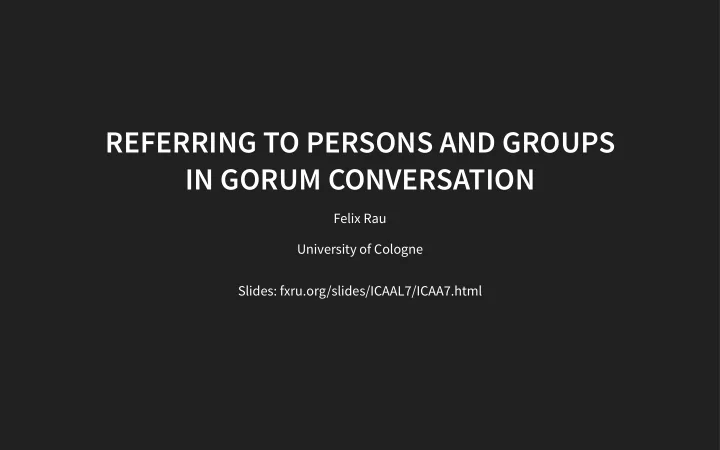

REFERRING TO PERSONS AND GROUPS IN GORUM CONVERSATION Felix Rau University of Cologne Slides: fxru.org/slides/ICAAL7/ICAA7.html
REFERENCE IN CONVERSATION Project on audio recognition (overlap) Backchannels Virtually nothing on Austroasiatic Very much work in progress
REFERRING “it is the speaker who refers […]: he invests the expression with reference by the act of referring” (Lyons 1977, p. 177)
REFERRING TO A PERSON
SACKS & SCHEGLOFF (1979) 1. minimization 2. recipient design
ENFIELD (2013)
1. Design the expressions for the recipient 1. achieve recognition 2. invoke or display relationship proximity/type 2. Minimize the expressive means 1. use a single reffering expression 2. use a name rather than a description 3. use only one name for a binomial if possible 3. Fit the expressive format to the action being performed 4. Observe local cultural/intitutional contraints 5. Associate the referent explicitly with one of the speech participants
ESTABLISHING REFERENCE IS INTERACTIONAL LK: ʈail ɖa'd ɖabu bo̰j baro so neta̰jju nekuʔ ‘for the tiles, I have given twelve hundred’ bãkita arlaŋ ‘no loan yet’ sidannuʈa ‘the ones from Sida’ DD: (mm) ‘uh huh’ LK: (lu)p inɖeŋolnu siɖannuʈa ‘Sida of Upper Inɖeŋol’ DD: ʔoʔo ‘oh yes’
“In making reference […], a speaker must select from a variety of lexical and gestural possibilities. Reference is therefore a matter of selection, whether lexical or otherwise.” (Enfield 2013, p. 433)
CULTURAL AND LINGUISTIC INVENTORY pronouns given names nick names kinship terms full names
(1) no'd 3sPRO.DIR ‘(s)he’ (2) subas=ɖi Subas=DEF ‘Subas’ (3) baiŋon=ɖi eggplant=DEF ‘Eggplant (a boy)’ (4) aba=niŋ father=1sPOSS ‘my father’
REFERENCE TO GROUPS (5) no'dgi 3pPRO.DIR ‘they’ (6) miŋ=ɖu babu=ɖi I=and Babu=Def ‘me and the sir’ (7) buboŋ gutor=ɖigin boy girl=DEF:PL ‘the boys and girls’ (8) ana=niŋ=gi elder.brother=1sPOSS=PL ‘my elder brothers’
ASSOCIATIVE PLURALS (9) liti=n=gi Liti=DEF=PL ‘Liti and so’ (10) amkṵj=niŋ=gi woman=1sPOSS=PL ‘my wife and so’ (11) garɖu=ɖigin=nu as̰uŋ guard=DEF:PL=ATTR house ‘the forest guard’s family’s house’
BACKCHANNELS (MINIMAL RESPONSES) The Uh huh , Mm , Huh? , and Yeah s of the world.
problematic term not essentially different from other utterances not constitute a separate channel do not claim the floor overlap is seemingly unproblematic
Continuers (e.g. Mm hm, Uh huh) Acknowledgements (e.g. Mm, Yeah) Newsmarkers (e.g. Really?, change-of-state token Oh, the ‘idea-connector’ Right) Change-of-activity tokens (e.g. Okay, Alright) Assessments (e.g. Great, How intriguing, �� ); Brief questions (e.g. Who?, Which one?, or Huh?); Collaborative completions (“finishing each others s...”) sighs , laughter , nods etc.
MINIMAL RESPONSES CROSSLINGUISTICALLY Are these function universal? Language specific inventories? Huh?
MINIMAL RESPONSES IN GORUM Continuers/ Acknowledgement: mm / ə̃ change-of-state/recognition: ( ʔ )o ʔ o
EXAMPLE 1 LK: gãsi tile'ɟɖi (.50) boɖnai gãsi tile'ɟɖi (.33) ‘old man Gansi, old man Gansi Bodnaik’ DD: ә̃ ‘uh huh’ LK: aɖi mersa koɖkejju (olku) ‘he was digging up the chili plants’ DD: ә̃ ‘uh huh’
EXAMPLE 2 LK: ʈail ɖa'd ɖabu bo̰j baro so neta̰jju nekuʔ ‘for the tiles, I have given twelve hundred’ bãkita arlaŋ ‘no loan yet’ sidannuʈa ‘the ones from Sida’ DD: (mm) ‘uh huh’ LK: (lu)p inɖeŋolnu siɖannuʈa ‘Sida of Upper Inɖeŋol’ DD: ʔoʔo ‘oh yes’
EXAMPLE 3 DD: norsiŋɖi ajtun ‘Norsing and Aitu’ LK: ʔo ʔo ʔo ‘yeah!’ DD: miŋnuʈa ‘are mine (my Panziabai/ritual relatives)’ LK: ә̃ ә̃ ә̃ norsiŋɖi ajtun ‘uh huh, uh huh, Norsing and Aitu’ DD: moɖun ‘Modu’ LK: ә̃ ә̃ ‘uh huh’ DD: kulnan ‘Kulna’ LK: ә̃ ‘uh huh’ DD: no'dnuʈa ‘are his’ LK: inɖi banzaɖiginnuʈa ‘this nephew’s household’s’ DD: ә̃ ‘uh huh’ LK: ә̃ ‘uh huh’
EXAMPLE 4 LK: uɖubun kajki bileŋ lupɖinu dorrajgi ‘yesterday, the one of our oldest one brought tiles perhaps’ DD: ә̃ .ә̃ ‘uh huh’ LK: Domunu ‘of Domu’ DD: ʔo ʔo ‘oh yes’ LK: panongi neʔ ujjḛj dorrajgi ‘Pano and so went and brought some subasɖigin neʔ Subas and so’ DD: ә̃ .ә̃ ‘uh huh’ LK: duarejjej ‘they moved them.’
... AND NOW? Gorum seems to be broadly in line with what we know of reference in conversation We need a better understanding of the function of mm, ə ̃ , and ( ʔ )o ʔ o associative plurals are a fascinating window into the way social structure is negotiated more data and more time or better tools to analyse the data
THANK YOU! Contact: f.rau@uni-koeln.de Slides: fxru.org/slides/ICAAL7/ICAA7.html
Recommend
More recommend